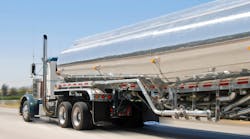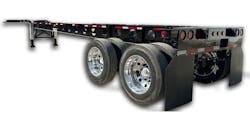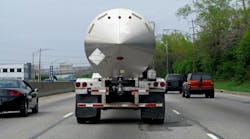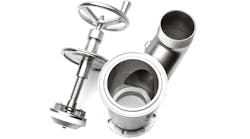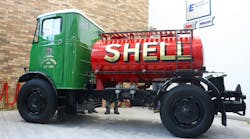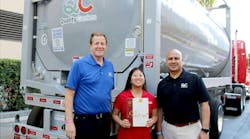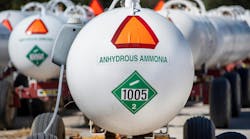A CATASTROPHIC failure of a fiberglass reinforced plastic (FRP) tank trailer in late 2009 put the tanks and their special permit status under scrutiny at the Department of Transportation (DOT). It's almost certain that the department will take action in the coming months.
A panel of FRP trailer experts recently examined what could and should be done to prevent such incidents in the future. The panel was part of a packed agenda at the National Tank Truck Carriers (NTTC) 2010 Cargo Tank Maintenance Seminar held November 8 to 10 in Louisville, Kentucky.
The incident in question occurred in 2009 when an FRP tank trailer hauling a Class 8 hazardous waste solution reportedly split open while in transit spilling the entire load. The initial investigation showed that the cargo was an extremely strong liquid waste consisting of a mixture of several materials. The FRP cargo tank was about 14 years old with the original inner barrier. The investigation also found that other cargo tanks used to transport the waste mixture showed severe damage to the inner barrier.
What to do?
Opening the panel discussion NTTC President John Conley asked the audience: “Is there we can do proactively as an industry regarding operating procedures, tank testing, and such? What can we do to address the issue? Should we focus more attention on waste products, which seem to be more of a problem than virgin chemicals?
“Is there enough information on testing and inspecting these cargo tanks? We work with DOT on cargo tank training workshops, and we have seen that a lot of information is available from government and industry on testing and inspecting different types of cargo tanks. The notable exception is FRP trailers.
“Are special permits the right approach for FRP tanks? Every FRP tank manufacturer operates under a different special permit. There is no consistency or uniformity to the special permits. Would it be better to have an FRP spec in the cargo tank regulations, as is the case in Canada?
“DOT is almost certain to do something on this issue. They feel they have an obligation to take action, and everything is on the table.”
FRP code tank
Joe Evans with DOT's Federal Motor Carrier Safety Administration said FRP tank manufacturers and tank owners should consider whether it would be better to take a proactive approach with DOT. One option would be to petition DOT to adopt FRP tank construction standards in 49 CFR to replace the current special permits. Uniform testing and inspection procedures could be part of the specification.
“I think we manufacturers are in agreement that this could be the right direction,” said Chris Kellogg, Corrosion Companies Inc, which makes FRP tanks for trailerizing by Beall Corporation. “My company has been in the composite tank business for over 32 years, and we know what it takes to ensure that FRP tanks operate safely.”
George Felix, Poly-Coat Systems Inc, which constructs FRP tanks for trailerizing by The Walker Group of companies, said that the industry wants to bring composite tank trailers into line with the way other cargo tanks, such as those fabricated from stainless steel, are inspected and tested.
Agreement came from Denis Marcus, Comptank Corporation, who added that the FRP tank incident in 2009 was very unfortunate, even more so because it involved a Comptank trailer. “We have been manufacturing FRP trailers since 1986, and we also run a truck fleet that operates FRP trailers,” he said. “More than 700 Comptank trailers are on the road today. These are safe and reliable trailers as long as they are maintained properly and haul the appropriate cargoes.”
Alain Chatillon, Tankcon FRP Inc, said he believes incompatible cargo was the biggest factor resulting in the failure of the Comptank trailer. “That sort of failure could have happened in any tank trailer, not just one made of FRP,” he said. “Among all of the manufacturers, we've got about 2,000 FRP trailers on the road. We're talking about one major incident right now. We need to keep in perspective the fact that other types of cargo tanks — steel, rubber-lined, and so on — have experienced similar incidents. We've been building FRP tanks for more than 30 years, and the record shows that we must be doing something right.”
Improvement suggestions
Could improvements be made? Panel members agreed that a number of factors could be improved. Carriers and shippers must have a clear understanding of the products that can be safely transported in FRP tanks based on the lining characteristics.
“We get plenty of calls from our customers asking about product compatibility,” Marcus says. “We turn to the fiberglass and lining material specialists, because we respect their knowledge.”
Ashland Performance Materials, the manufacturer of the Derakane lining material used in a majority of FRP cargo tanks, is one of those expert sources. Michael with Ashland Performance Materials, said many carriers do contact his company to ask about cargo compatibility with the lining.
“We get four to five questions a week from carriers,” he added. “We provide advice on which resin material works best with the various chemical cargoes. We've posted a chemical resistance guide on our website (derakane.com), and we have accumulated considerable data for various applications, including transport and storage tanks.
“Ashland's corrosion guides do a very good job, but the corrosion compatibility process really starts with you the carrier. You have to make sure that you are comfortable with the corrosion guide data. Call us if you still have questions.”
Felix cautioned that even with the expert help, it is sometimes difficult to get a definitive recommendation for FRP tank lining material when the cargo is a specialty chemical. “What you have to do in those cases is track the product back through the manufacturing process to see what types of materials the plant is using for piping and storage tanks.”
Inspections and tests
Testing, inspecting, and repair are critical factors for fleets running FRP tanks. It all starts with using a repair shop that has a CT certificate listing FRP tanks. “Fleets will face problems with the DOT if they use a shop that lacks a CT certificate listing FRP cargo tanks,” Conley said.
Annual internal visual inspections and pressure tests should be the standard for FRP trailers, and cargoes should be considered corrosive to the tank for the purposes of inspection and testing procedures. DOT officials said most of the special permits call for annual tests and inspections.
Kellogg said fleets need to make sure that authorized repair shops know what the corrosion barrier thickness should be before inspecting an FRP trailer. That information is available from the manufacturer. Mechanics need to track the depth of corrosion in an FRP trailer lining just like they do pitting in a steel cargo tank.
Every internal inspection needs photographic documentation. “We take photographs of the tank interior for every FRP trailer in our fleet,” Marcus said. “We compare year-to-year photos to monitor the effects of corrosion.”
When tank repairs are needed, they must be made by a qualified shop. “We have found that some FRP tank users turn to non-qualified shops, such as fiberglass swimming pool manufacturers,” Chatillon said.
Authorized repairs typically are handled by the FRP tank manufacturers, according to Marcus. Most of the special permits state that structural repair work on the tank has to go back to the manufacturer. At the very least, fleets need to communicate with the manufacturer before sending any FRP trailer out for repair. ♦
